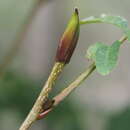pms
nòm ant ël fil


Pterocarya rhoifolia (Japanese wingnut, Japanese: sawagurumi)[1] is a species of tree in the Juglandaceae family that is widely distributed throughout Japan, and also found native to China in the Laoshan District in eastern Shandong Province.[2][3]
The tree flourishes in moist areas along riverbanks and mountain streams, and attains 30 m (98 ft) in height, flowering from May–July.[3]
It is a soft light wood, with the heartwood yellowish-white in color, which has been used as a substitute of kiri (Paulownia tomentosa), for example, to make geta clogs that are imitations of kiri-geta. It is straight-grained and the pore pattern on the surface provides the wood with a handsome appearance.[4]
{{cite journal}}: Cite journal requires |journal= (help) Pterocarya rhoifolia (Japanese wingnut, Japanese: sawagurumi) is a species of tree in the Juglandaceae family that is widely distributed throughout Japan, and also found native to China in the Laoshan District in eastern Shandong Province.
 Fruiting tree
Fruiting tree The tree flourishes in moist areas along riverbanks and mountain streams, and attains 30 m (98 ft) in height, flowering from May–July.
It is a soft light wood, with the heartwood yellowish-white in color, which has been used as a substitute of kiri (Paulownia tomentosa), for example, to make geta clogs that are imitations of kiri-geta. It is straight-grained and the pore pattern on the surface provides the wood with a handsome appearance.
Pterocarya rhoifolia es una especie de árbol perteneciente a la familia Juglandaceae que crece en las áreas húmedas a lo largo de las riveras de los ríos y arroyos de montañas en el este de Shandong, China y en Japón.[1]
Son árboles que alcanza un tamaño de 30 metros de altura. Hojas pinnadas impares, de 20-25 (-40) cm, pecíolos de 3-7 cm, pubescentes, raquis sin alas, pubescentes; foliolos de (7 -) 11-21; folíolos laterales con peciólulo de 1,5 mm, lámina ovado-oblongas a oblanceoladas ampliamente, 6-12 × 1.5-4 cm, pubescentes abaxialmente lanudo a lo largo de nervio central y nervios secundarios, base oblicua, redondeada o ampliamente cuneada, ápice acuminado. Fructificación pico 20-30 (-49) cm, eje pubescente. Núculas 8-9 mm, base redondeada, ápice obtuso cónico, glabro; alas semiorbicular, de 1.3-2.1 × 0.9-1.8 cm. Fl. Mayo, fr. Jun-julio Áreas húmedas orillas de los ríos y arroyos de montaña. E Shandong (Lao Shan) [Japón].[2]
Pterocarya rhoifolia fue descrita por Siebold & Zucc. y publicado en Flora Japonica 141. 1845.[3]
Pterocarya rhoifolia es una especie de árbol perteneciente a la familia Juglandaceae que crece en las áreas húmedas a lo largo de las riveras de los ríos y arroyos de montañas en el este de Shandong, China y en Japón.
Pterocarya rhoifolia est une espèce d'arbres à feuilles caduques de la famille des Juglandaceae originaire du Japon. Il présente un port plutôt étalé. Les feuilles, longues de 30 à 40 cm, sont composées pennées : 15 à 21 folioles oblongues ovales, effilées, de couleur vert moyen lustré, se présentent sur la nervure principale.
Il fleurit en juin puis apparaissent des petits fruits verts ailés, en épis, pendants, de près de 30 cm de long à maturité. Un peu plus grand que les autres Pterocarya, il mesure jusqu'à 30 m de haut pour 25 m de diamètre.
Japansk vingenøtt (Pterocarya rhoifolia) er et løvfellende tre i valnøttfamilien. Det blir opptil 30 m høyt. Bladene er finnete og 20–25 cm lange. Treet vokser langs bredden av elver og bekker. Japansk vingenøtt finnes hovedsakelig i Japan, men forekommer også i Laoshan i den østlige kinesiske provinsen Shandong.
Japansk vingenøtt (Pterocarya rhoifolia) er et løvfellende tre i valnøttfamilien. Det blir opptil 30 m høyt. Bladene er finnete og 20–25 cm lange. Treet vokser langs bredden av elver og bekker. Japansk vingenøtt finnes hovedsakelig i Japan, men forekommer også i Laoshan i den østlige kinesiske provinsen Shandong.
Skrzydłorzech japoński (Pterocarya rhoifolia Siebold & Zucc.) – gatunek drzewa z rodziny orzechowatych. Występuje naturalnie w Japonii (jest tam jednym z najwyższych drzew)[3][4] oraz we wschodniej części prowincji Szantung we wschodnich Chinach[5]. Rośnie w lasach nad strumieniami i rzekami, często jako dominant w różnych zespołach łęgowych[6].
Fanerofit. Preferuje stanowiska w pełnym nasłonecznieniu. Roślina szybkorosnąca. Dobrze rośnie na glebie kwaśnej bądź obojętnej. Jest mrozoodporny (6B-8B strefa mrozoodporności), lecz może być uszkadzany przez późne przymrozki. Źle znosi suszę[4][7]. Kwitnie w maju, owocuje od czerwca do lipca[5]. Osiąga wiek ok. 150 lat[6].
Skrzydłorzech japoński (Pterocarya rhoifolia Siebold & Zucc.) – gatunek drzewa z rodziny orzechowatych. Występuje naturalnie w Japonii (jest tam jednym z najwyższych drzew) oraz we wschodniej części prowincji Szantung we wschodnich Chinach. Rośnie w lasach nad strumieniami i rzekami, często jako dominant w różnych zespołach łęgowych.
Pterocarya rhoifolia là một loài thực vật có hoa trong họ Juglandaceae. Loài này được Siebold & Zucc. miêu tả khoa học đầu tiên năm 1845.[1]
Pterocarya rhoifolia là một loài thực vật có hoa trong họ Juglandaceae. Loài này được Siebold & Zucc. miêu tả khoa học đầu tiên năm 1845.
水胡桃(学名:Pterocarya rhoifolia)为胡桃科枫杨属下的一个种。
|access-date=中的日期值 (帮助)